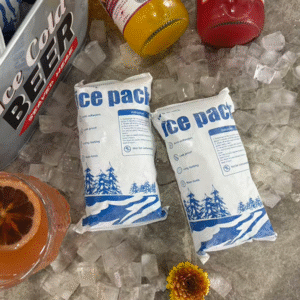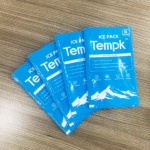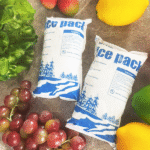Introduction
Maintaining precise temperature control has become a defining factor of success in modern logistique de la chaîne du froid. As supply chains become more complex and sustainability demands rise, businesses must adopt innovative cooling solutions that are both efficient and eco-conscious.
Dry ice foam and ice packs now lead the way — offering superior temperature stability for sensitive products like vaccins, fruit de mer, and specialty foods. Dans ce guide, you’ll learn how these tools enhance logistics efficiency, sécurité, and compliance across the global supply chain.
-
How dry ice foam improves thermal stability and reduces transit risks
-
Why dry ice packs are ideal for pharmaceuticals and food shipping
-
Best practices for handling and safety in temperature-sensitive logistics
-
Dernier 2025 innovations shaping cold chain packaging and sustainability
1. What Makes Dry Ice Foam an Ideal Cooling Solution for Logistics?
Dry ice foam provides high insulation and consistent cooling performance, making it a preferred choice for long-haul and last-mile cold chain shipments. Its unique cellular structure minimizes sublimation loss and maintains product integrity even under extreme temperature fluctuations.
Why Businesses Prefer Dry Ice Foam Over Traditional Refrigerants
Dry ice foam offers uniform cold retention, meaning temperature remains stable across the entire cargo space. Traditional gel packs or water ice often struggle to maintain low temperatures over time, especially during multi-day transport.
En outre, le foam structure absorbs CO₂ gas release gradually, ensuring safety and extending product life. Logistics managers appreciate its lightweight nature, which translates into lower transportation costs — a key consideration for pharma and food exporters.
| Fonctionnalité | Mousse de glace carbonique | Glace traditionnelle | Impact commercial |
|---|---|---|---|
| Durée de refroidissement | Jusqu'à 72 heures | 12–24 heures | Fewer replenishment cycles, réduire les coûts |
| Efficacité pondérale | Léger | Lourd | Reduced freight cost |
| Plage de température | -78.5°C constant | 0°C | Enables ultra-cold chain |
| Durabilité | Recyclable foam materials | Limited reuse | Supports ESG compliance |
Key Takeaways for Logistics Managers
-
Enhance route reliability: Use dry ice foam for long-distance routes with variable climates.
-
Reduce wastage: Minimize product loss due to temperature excursions.
-
Lower carbon footprint: Choose foam materials made from recycled CO₂-based polymers.
Exemple: A global seafood exporter using dry ice foam reduced spoilage rates by 23% and shipping costs by 12% compared to traditional gel-based cooling systems.
2. How Do Dry Ice Packs Ensure Temperature Integrity in Pharma and Food Transport?
Dry ice packs offer precision-controlled cooling for critical goods, ensuring temperature remains within strict tolerance levels for pharmaceuticals, biologique, et périssables.
Applications dans toutes les industries
-
Logistique pharmaceutique: Vaccins, insuline, and biological samples require stable sub-zero temperatures. Dry ice packs can maintain -20° C à -80 ° C, assurer le respect des PIB (Bonne pratique de distribution) lignes directrices.
-
Distribution alimentaire: Viande, fruit de mer, laitier, and gourmet items stay fresh without bacterial growth.
-
Commerce électronique et kits repas: Dry ice packs enable efficient delivery of temperature-sensitive products directly to consumers while preserving brand reputation.
Comparaison des performances: Packs de glace carbonique vs. Packs de gel
| Cooling Property | Paquet de glace sec | Pack de gel | Impact du monde réel |
|---|---|---|---|
| Plage de température | -78° C à -20 ° C | 0° C à 5 ° C | Idéal pour les vaccins, not just food |
| Durée | 24–72 heures | 12–24 heures | Reduces need for restocking |
| Conformité | Meets WHO and IATA standards | Limité | Approved for medical shipping |
| Sécurité | Vented and insulated | Non-vented | Prevents gas buildup in packaging |
Résultat: Dry ice packs are the backbone of modern temperature-controlled logistics, combining reliability with operational flexibility.
3. What Safety Measures Are Essential When Handling Dry Ice in Transit?
Safety in logistics goes beyond product integrity — it also concerns employee well-being and regulatory compliance.
Pratiques de manipulation sécuritaires
-
Utiliser des conteneurs ventilés: Prevent CO₂ gas buildup during sublimation.
-
Portez des gants de protection: Un contact direct peut provoquer des engelures.
-
Étiquetez clairement les colis: Indicate “Dry Ice – UN1845” with correct weight.
-
Maintain airflow in vehicles: Especially for bulk shipments to avoid oxygen depletion.
Temperature and CO₂ Management
Pour assurer des performances optimales, maintenir CO₂ concentration below 5000 ppm Dans les espaces confinés. This prevents health hazards while complying with international transport standards.
Étude de cas: A pharmaceutical shipper introduced automated CO₂ venting systems in its refrigerated trucks and reduced incident rates by 30% while improving regulatory audit scores.
Safety Checklist Summary
-
✅ Gloves and eye protection during handling
-
✅ Insulated but vented packaging
-
✅ CO₂ monitoring in closed environments
-
✅ Training for warehouse and logistics staff
4. How Can Cold Chain Companies Optimize Efficiency with Dry Ice Foam Systems?
Efficiency in cold chain logistics now depends on data, automation, et matériaux durables. Dry ice foam systems support all three.
Integrating Dry Ice Foam into Your Operations
-
Optimisation des itinéraires: Combine foam insulation with real-time temperature data to minimize re-icing frequency.
-
Storage Management: Use modular foam inserts to standardize packaging and reduce waste.
-
Refroidissement hybride: Pair foam with phase change materials (PCM) for flexible temperature ranges.
Measurable Business Benefits
| Métrique | Before Dry Ice Foam | After Implementation | Operational Outcome |
|---|---|---|---|
| Spoilage Rate | 8% | 2% | +6% quality improvement |
| CO₂ Emissions | 100 unités | 70 unités | 30% réduction |
| Labor Cost | Haut | Modéré | Automated cooling setup |
| Compliance Score | 80% | 98% | Audit-ready logistics |
Conseil pratique: Train your warehouse team to handle foam inserts efficiently. Their reusability can save thousands annually in packing materials.
5. Durabilité environnementale: Is Dry Ice Foam Truly Eco-Friendly?
Oui - modern dry ice foam systems are engineered with sustainability in mind. Unlike traditional refrigerants, which rely on synthetic chemicals, dry ice foam uses captured CO₂ from industrial processes.
Eco-Benefits Overview
-
Closed-loop carbon use: Captured CO₂ is reused, not emitted.
-
Isolation recyclable: Foam components can be reprocessed for future shipments.
-
Reduced water waste: Contrairement à la glace, no melting residue or leakage occurs.
Aligning with ESG and Corporate Goals
B2B buyers increasingly require carbon accountability. Using CO₂-based cooling can count toward Scope 3 emission reductions under many global sustainability frameworks.
| Sustainability Metric | Mousse de glace carbonique | Glace traditionnelle | Avantage |
|---|---|---|---|
| Water Usage | Aucun | Haut | Réduit les déchets |
| Recyclabalité | Haut | Faible | Enhances reuse rate |
| Carbon Source | Captured CO₂ | Fresh CO₂ | Circular process |
Exemple: A European pharma distributor achieved net-zero cooling operations by combining renewable energy with recycled CO₂-based dry ice foam.
6. 2025 Tendances: The Future of Dry Ice Foam and Ice Pack Logistics
Avancées technologiques
-
Capteurs intelligents: Continuous IoT monitoring ensures transparency and traceability.
-
AI Route Planning: Predictive algorithms suggest optimal cooling loads based on shipment duration and geography.
-
Next-Gen Packaging: Bio-based foams reduce landfill waste while maintaining thermal integrity.
Insistance au marché
Selon Cold Chain Market Outlook 2025, le global dry ice logistics market will reach $8.7 milliard, grandir à un 7.4% TCAC, driven by vaccine transport and cross-border food trade.
Emerging Opportunities:
-
Intégration de carbon-neutral dry ice manufacturing
-
Growth in last-mile cold delivery solutions for e-commerce
-
Adoption de automated refreezing stations at logistics hubs
7. FAQ: Addressing Common Cold Chain Questions
Q1: How long does dry ice foam last during transit?
Typiquement 48 à 72 heures, en fonction de l'isolation et de la température ambiante. Foam insulation reduces sublimation, extending duration by up to 30% compared to loose dry ice.
Q2: Is dry ice foam safe for pharmaceutical transport?
Oui. It complies with GDP and IATA standards and provides stable ultra-cold conditions without chemical residue.
Q3: Can dry ice foam be reused?
Absolument. Many foam structures are designed for multiple cycles, reducing waste and cost per shipment.
Q4: What is the ideal temperature for vaccine transport using dry ice packs?
Entre -60°C and -80°C, ensuring biological stability without freeze damage.
Q5: Are there environmental concerns with dry ice?
Not when produced from sources de CO₂ recyclées. The process repurposes emissions, supporting circular economy principles.
8. Résumé et recommandations
Principaux à retenir:
-
Dry ice foam ensures stable cooling, longue durée, and eco-efficiency.
-
Packs de glace sec are essential for pharmaceuticals and perishables requiring strict compliance.
-
Integrating both solutions improves operational reliability and reduces environmental impact.
Action Plan for Logistics Leaders:
-
Audit your current temperature-control systems.
-
Introduce dry ice foam for long-haul or high-value cargo.
-
Train staff on CO₂ safety and reusability best practices.
-
Collaborate with suppliers offering carbon-neutral foam materials.
Pour la pointe: Start small with a regional pilot program before scaling enterprise-wide to measure savings and CO₂ impact accurately.
À propos du tempk
À Rotation, Nous nous spécialisons dans advanced cold chain packaging and temperature-control technologies for global logistics networks. Our expertise lies in creating sustainable, high-performance cooling systems — from dry ice foam inserts à packs de glace réutilisables — tailored to pharmaceutical, biotechnologie, and food sectors.
With over a decade of experience optimizing cold chain infrastructure, we help companies reduce waste, réduire les coûts, and meet ESG goals.
Ready to transform your logistics efficiency?
👉 Contact Tempk today for expert consultation on integrating dry ice foam and ice packs into your cold chain strategy.
























